Are you curious about the largest birds that call Pennsylvania home? Look no further!
In this article, we’ll explore the magnificent Bald Eagle, the swift Northern Harrier, and the agile Sharp-shinned Hawk, among others. Discover their impressive wingspans and fascinating behaviors as we delve into the world of the largest birds in Pennsylvania.
Get ready to be amazed by these majestic creatures that grace our skies.
Key Takeaways
- The Bald Eagle is a symbol of strength and freedom and has experienced population recovery thanks to conservation efforts.
- The Northern Harrier is found in open habitats and relies on hearing and low flight for hunting. Its habitat preferences are tied to the availability of hunting grounds.
- The Sharp-shinned Hawk is a small but agile bird of prey that feeds on small birds and mammals. Some populations migrate south for winter.
- The Cooper’s Hawk is known for its incredible hunting skills and agility. It builds nests in tall trees, often near water sources, and mates for life.
Bald Eagle
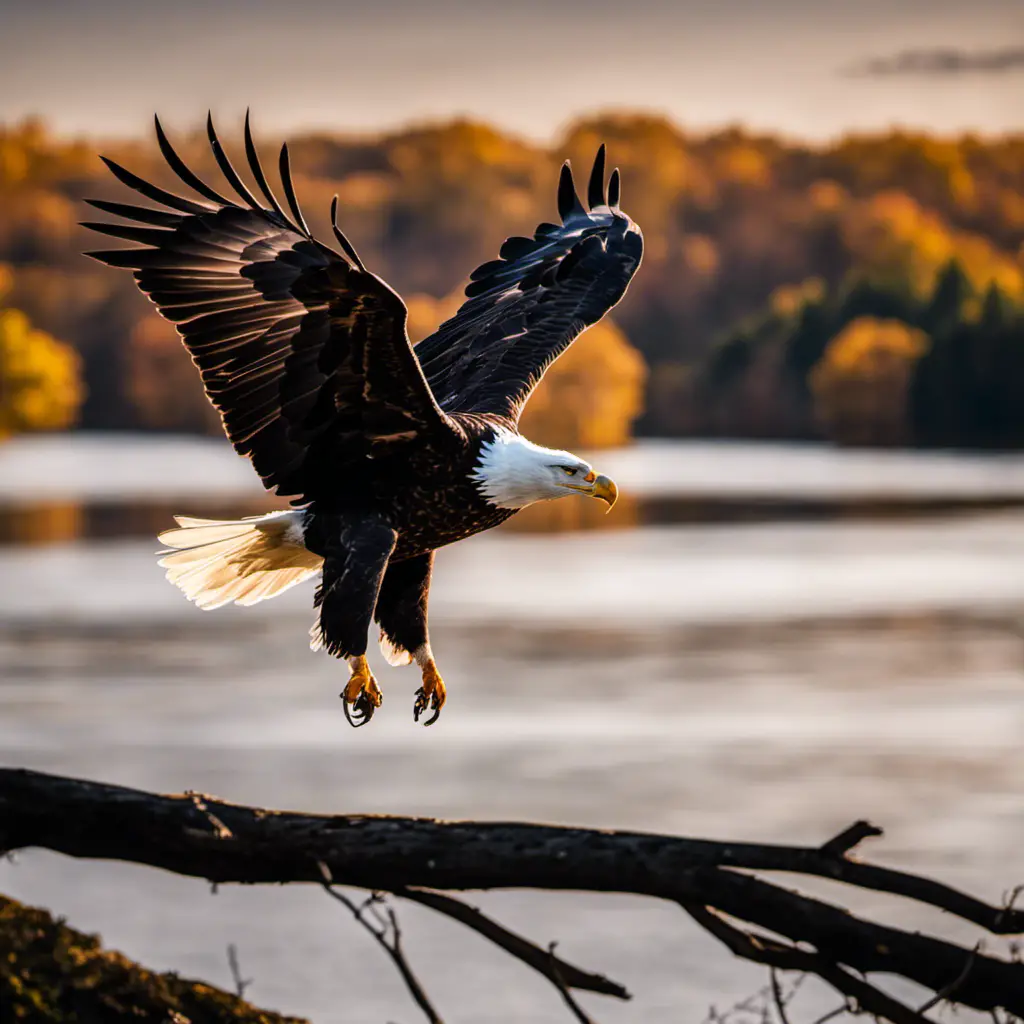
You can easily spot a bald eagle soaring high in the sky during your visit to Pennsylvania. These majestic birds are a symbol of strength and freedom.
Thanks to conservation efforts, the bald eagle population has made a remarkable recovery. The ban on DDT, a harmful pesticide, played a crucial role in their conservation. Other conservation efforts include protecting their habitats and nesting sites, as well as educating the public about the importance of preserving these birds.
However, despite these efforts, bald eagles still face threats. Habitat loss due to urbanization and deforestation is a major concern. Additionally, pollution and illegal hunting pose significant risks to their populations.
It’s essential to continue these conservation efforts to ensure the survival of these magnificent creatures for future generations to admire.
Northern Harrier

An article about the Northern Harrier can provide fascinating insights into the hunting behavior and unique physical characteristics of this bird of prey.
The Northern Harrier, also known as the Marsh Hawk, is a medium-sized raptor that’s commonly found in open habitats such as grasslands, marshes, and agricultural fields.
Its hunting behavior is distinct, as it relies on its exceptional hearing and low flight to locate and capture its prey, primarily small mammals and birds.
The Northern Harrier’s habitat preferences and population status are closely tied to the availability of suitable hunting grounds. Conservation efforts have been put in place to protect its habitats and ensure its survival.
Additionally, the Northern Harrier exhibits interesting migration patterns, with some individuals traveling long distances during the winter months.
Physical characteristics of the Northern Harrier include a slim body, long wings, and a distinctive white rump patch, which aids in identification.
Overall, understanding the hunting behavior, habitat preferences, and physical characteristics of the Northern Harrier is crucial for conservation efforts and appreciating the unique qualities of this magnificent bird.
Sharp-shinned Hawk

The Sharp-shinned Hawk is a small but agile bird of prey that’s known for its swift flight and sharp talons. This species, scientifically known as Accipiter striatus, is a member of the Accipitridae family.
Sharp-shinned Hawks are found throughout North America and are particularly known for their hunting skills. These birds have long, slender bodies and short, rounded wings that enable them to maneuver effortlessly through dense vegetation. They mainly feed on small birds and mammals, relying on their sharp talons to capture and kill their prey.
One interesting aspect of the Sharp-shinned Hawk is its migratory patterns. Some populations of this species migrate south for the winter, while others are year-round residents in their breeding territories. The reasons behind these different migratory strategies are still being studied by scientists.
Overall, the Sharp-shinned Hawk is an impressive bird of prey that plays a vital role in maintaining the balance of nature.
Cooper’s Hawk

Have you seen how Cooper’s Hawks are known for their incredible hunting skills and agility? These impressive birds of prey have specialized adaptations that enable them to be highly efficient hunters. Cooper’s Hawks are medium-sized raptors with a wingspan of about 30 inches and a length of around 16 inches. They have short, rounded wings and long tails, which allow them to maneuver through dense vegetation while hunting.
Cooper’s Hawks primarily feed on small to medium-sized birds, which they capture in flight. They are known for their remarkable speed and agility, often chasing their prey through trees and using their sharp talons to grasp them. Their hunting behavior is characterized by short, powerful bursts of flight and sudden turns to ambush their unsuspecting prey.
In terms of habitat, Cooper’s Hawks can be found in a variety of environments, including forests, woodlands, and suburban areas. They typically build their nests in tall trees, often near water sources. These nests are made of sticks and lined with softer materials such as bark and leaves. Cooper’s Hawks are monogamous and usually mate for life.
| Characteristics | Description |
|---|---|
| Wingspan | Around 30 inches |
| Length | Approximately 16 inches |
| Hunting Behavior | Chases prey in flight, uses sharp talons |
| Habitat | Forests, woodlands, suburban areas |
| Nesting Habits | Builds nests in tall trees, often near water sources |
Overall, Cooper’s Hawks are fascinating birds of prey with exceptional hunting skills and specific habitat and nesting habits. Understanding their behavior and adaptations helps us appreciate their role in maintaining the balance of ecosystems they inhabit.
Northern Goshawk
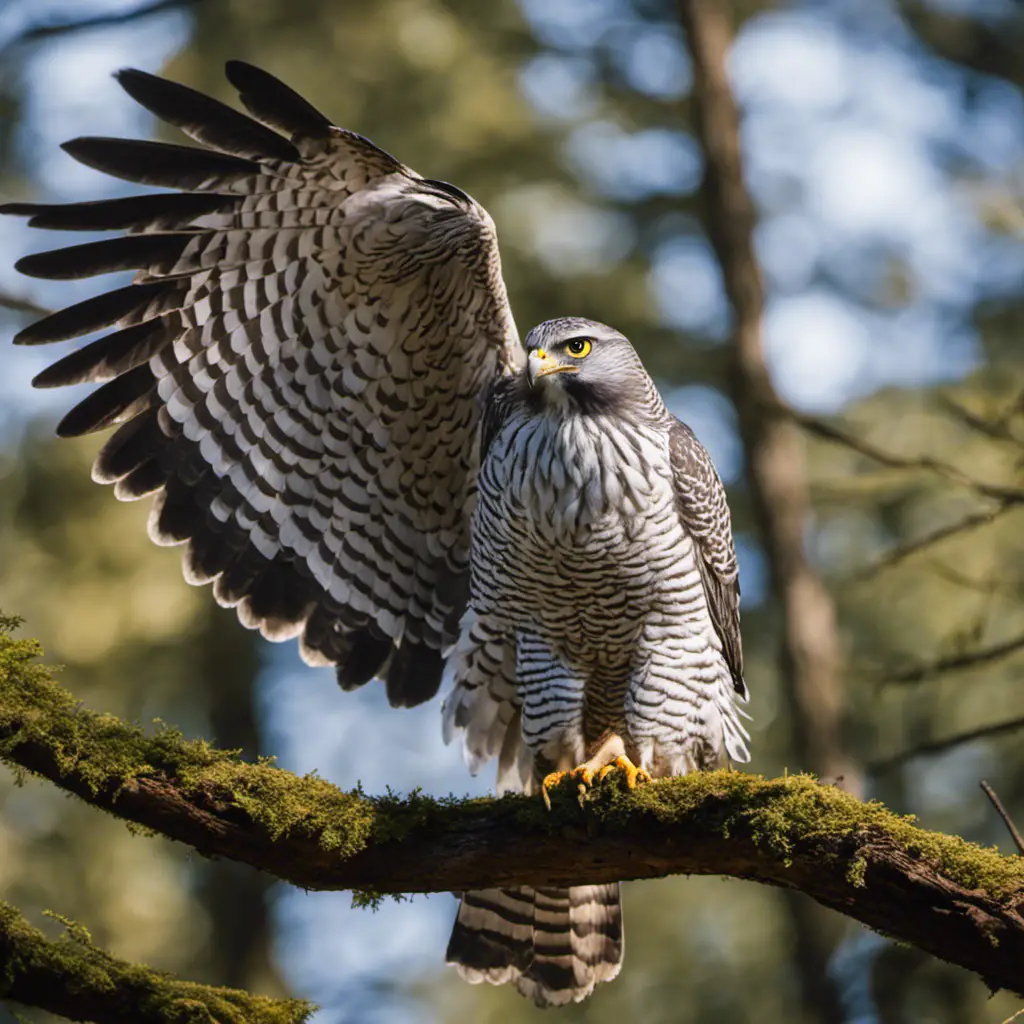
You’ll be amazed by the Northern Goshawk’s impressive hunting abilities and its ability to adapt to various environments. The Northern Goshawk, scientifically known as Accipiter gentilis, is a large bird of prey found in North America. It’s known for its agility and speed, making it a formidable predator. With its broad wings and long tail, the Northern Goshawk is designed for maneuverability and capturing prey in flight. Its diet mainly consists of small to medium-sized birds and mammals, and it employs various hunting techniques to catch its prey.
Predator-prey dynamics play a crucial role in the survival and balance of ecosystems. As an apex predator, the Northern Goshawk helps regulate populations of its prey, thereby maintaining ecological equilibrium. However, habitat conservation is critical for the sustainability of this magnificent bird. Loss of suitable habitats due to deforestation and urbanization can significantly impact the Northern Goshawk’s population.
Conservation efforts should focus on preserving large, intact forest areas where the bird thrives. By protecting its habitat, we can ensure the continued existence of this remarkable species and maintain the delicate balance of predator-prey dynamics in our ecosystems.
American Robin
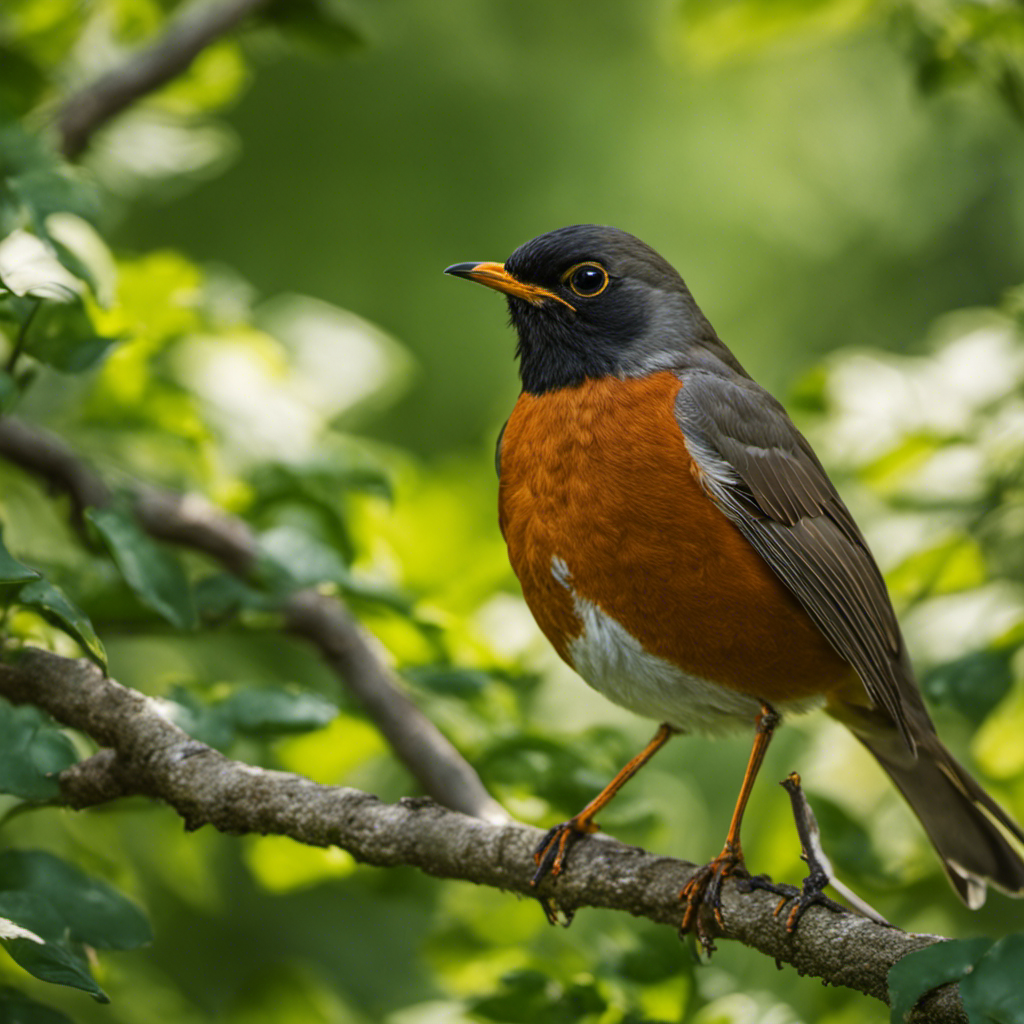
You can easily spot an American Robin in your backyard, and it is known for its distinctive red breast. These birds are a common sight across North America, including Pennsylvania. American Robins have interesting migration patterns, with some individuals traveling as far south as Mexico during the winter months. They are known to return to the same nesting grounds each year, often building their nests in trees or shrubs. The nesting habits of American Robins are fascinating, as they construct their nests using a combination of mud and grass, lined with fine materials such as feathers or hair. The female typically lays 3-5 pale blue eggs, which she incubates for about two weeks. The young robins leave the nest after about two weeks, but the parents continue to feed them for several more weeks until they are ready to fend for themselves. Overall, the American Robin is an intriguing bird with unique migration patterns and nesting habits.
| Migration Patterns | Nesting Habits |
|---|---|
| Travel to Mexico | Build nests in trees or shrubs |
| Return to same nesting grounds | Construct nests using mud and grass |
| Seasonal migration | Line nests with feathers or hair |
| Southward movement in winter | Lay 3-5 pale blue eggs |
| Return to North America in spring | Incubate eggs for about two weeks |
Red-tailed Hawk

If you look up in the sky, you’ll notice the majestic flight of a Red-tailed Hawk, a symbol of power and grace. Red-tailed Hawks are known for their hunting behavior, which involves a combination of soaring, searching, and diving. They typically hunt from a high perch, using their keen eyesight to spot prey such as small mammals, birds, and reptiles. Once they locate their target, they swoop down with incredible speed and accuracy, using their sharp talons to capture and kill their prey.
When it comes to nesting habits, Red-tailed Hawks are monogamous and typically mate for life. They build large nests, called aeries, high up in trees or on cliffs. These nests are made of sticks and lined with softer materials like leaves and grass. The female lays 1-3 eggs, and both parents take turns incubating them for about a month. After hatching, the young hawks stay in the nest for about 6-7 weeks before they’re able to fly and become independent.
Turkey Vulture
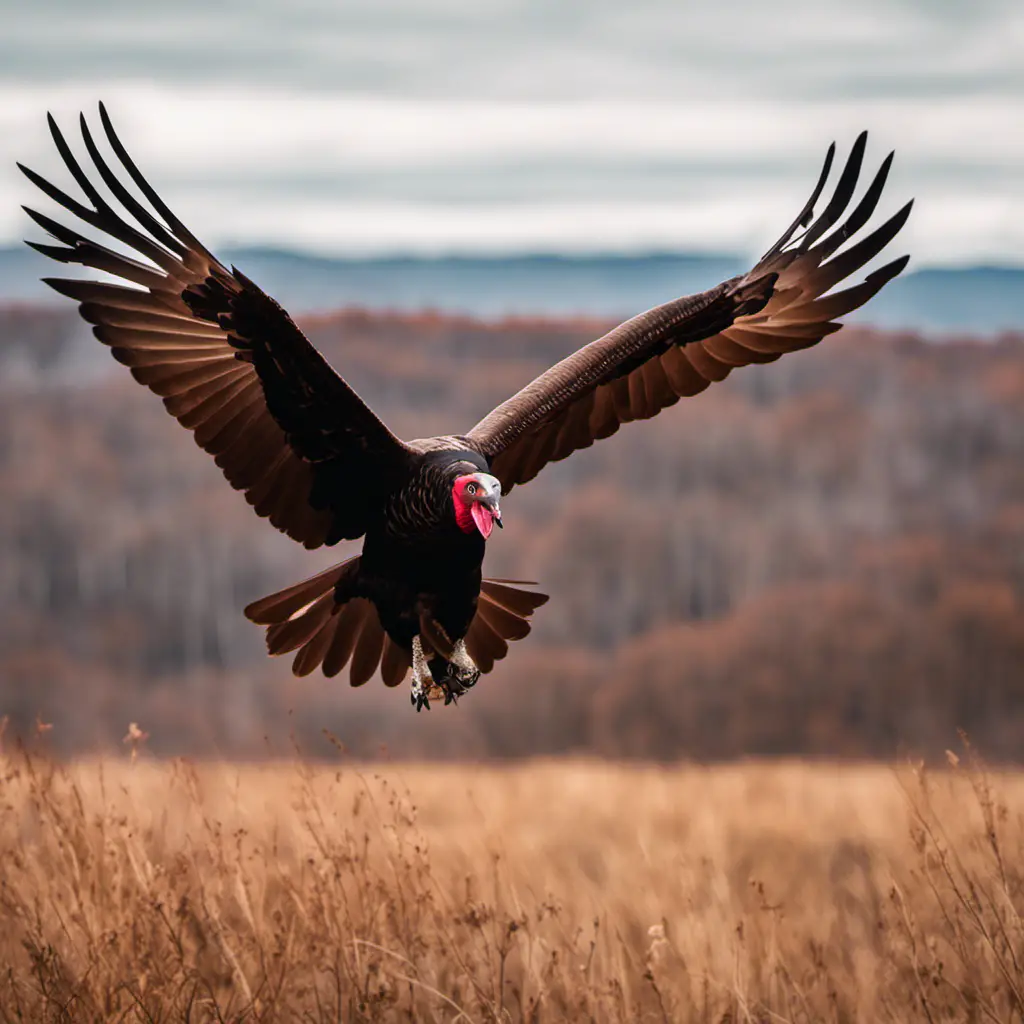
Take a moment to observe the graceful flight of a Turkey Vulture as it soars above, searching for carrion to feast on. The Turkey Vulture, scientifically known as Cathartes aura, is a large scavenger bird found in North and South America. These impressive creatures play a vital role in our ecosystems by cleaning up carrion, preventing the spread of disease. Turkey Vultures have a unique migratory pattern, with populations from northern regions of their range migrating south during the winter months. This behavior is influenced by the availability of food and temperature changes. To give you a better understanding, here is a table showcasing the migratory pattern of Turkey Vultures:
| Region | Migration Pattern |
|---|---|
| Northern | South during winter |
| Southern | Resident all year |
| Coastal | Partial migration |
| Mountainous | South during winter |
| Tropical | Resident all year |
Eastern Screech-Owl

Have you ever heard of an Eastern Screech-Owl? These small, nocturnal birds can be found throughout eastern North America, and they’re known for their distinctive screeching calls.
Nesting habits: Eastern Screech-Owls typically nest in tree cavities, but they can also use man-made nest boxes. They prefer deciduous or mixed forests with open spaces for hunting.
Diet and hunting techniques: These owls have a varied diet, including small mammals, birds, reptiles, and insects. They use their keen hearing and excellent night vision to locate prey. When hunting, they swoop down silently from perches or fly low over the ground.
Conservation efforts: Eastern Screech-Owls face threats from habitat loss and fragmentation. Conservation efforts include preserving suitable habitat, providing nest boxes, and reducing the use of pesticides.
Population trends: While overall population trends are difficult to determine, some areas have reported declines due to habitat loss and competition with invasive species.
Understanding the nesting habits, diet, conservation efforts, and population trends of Eastern Screech-Owls is crucial for their conservation and protection.
Great Horned Owl
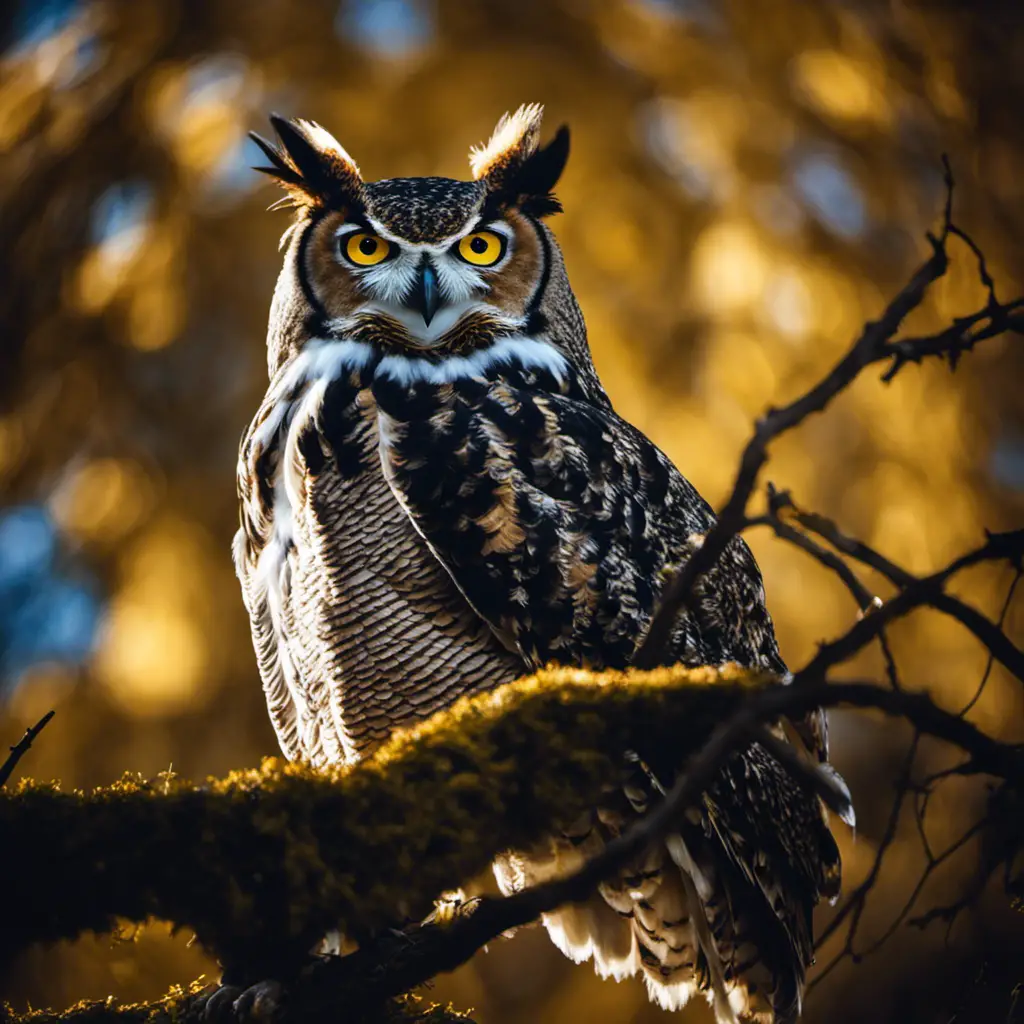
You can learn more about the Great Horned Owl by observing its large size and distinctive ear tufts. The Great Horned Owl is one of the largest owl species in Pennsylvania and is a common sight for bird watchers in the state.
This majestic bird is known for its powerful hunting capabilities and its ability to adapt to a variety of habitats. The Great Horned Owl can be found in a range of environments, from forests to open fields. It plays an important role in bird conservation by controlling populations of small mammals and other birds.
Its presence in different bird habitats in Pennsylvania is a testament to the diverse and thriving bird population in the state. Bird watching in Pennsylvania provides a unique opportunity to observe and appreciate the beauty and importance of species like the Great Horned Owl.
Barred Owl

Don’t miss out on the opportunity to witness the haunting beauty of the Barred Owl as it silently glides through the forest. This majestic bird, known for its striking appearance and distinct call, is a fascinating creature that has captured the interest of many.
If you’re curious about the conservation of the Barred Owl and its habitat preferences, here are some key points to consider:
- Barred owl conservation:
- Efforts are being made to protect the Barred Owl and its habitat due to declining populations in certain areas.
- Conservation measures include preserving old-growth forests, which are preferred nesting sites for the Barred Owl.
- Monitoring programs are implemented to track population trends and identify potential threats.
- Collaborative initiatives between conservation organizations and landowners aim to create sustainable habitats for the Barred Owl.
Understanding the conservation needs and habitat preferences of the Barred Owl is crucial for ensuring its survival in the wild. By supporting conservation efforts and respecting their natural habitats, we can contribute to the preservation of this remarkable species.
Osprey
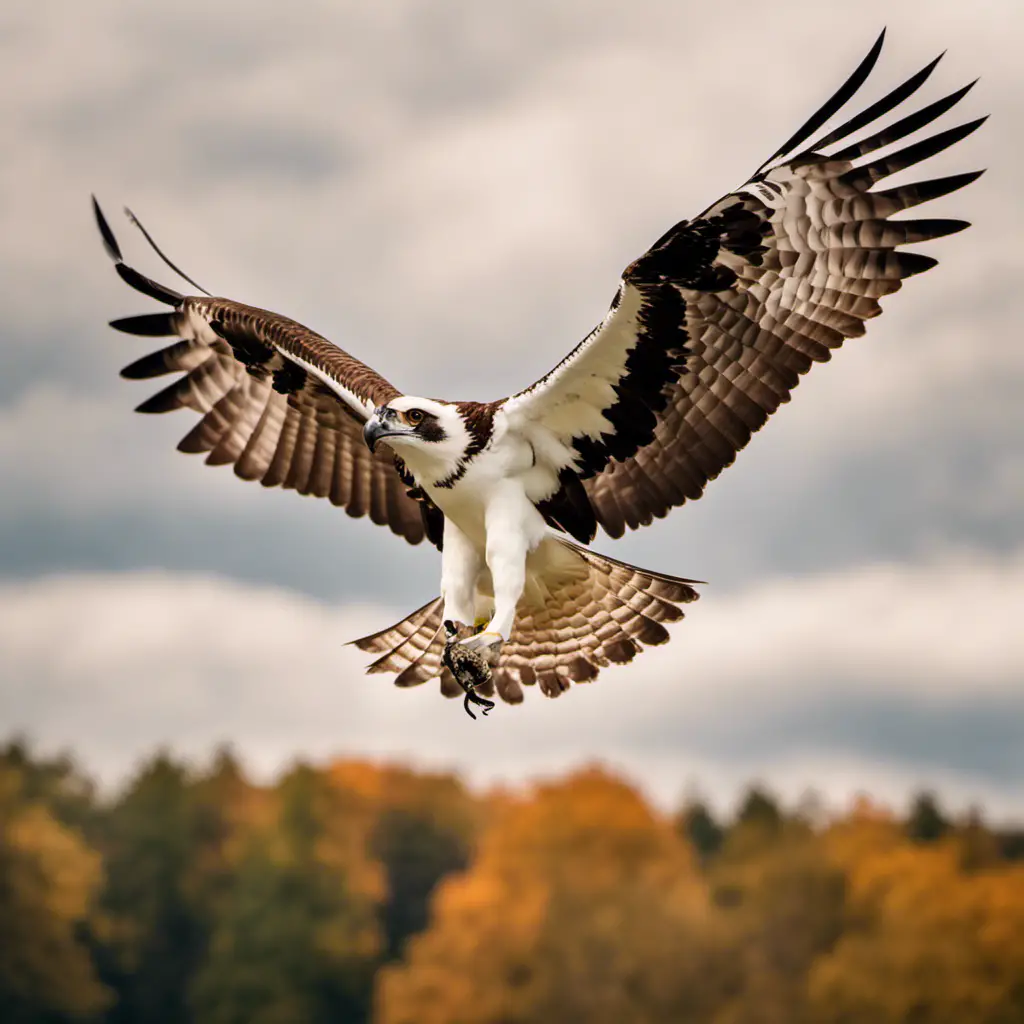
Spotting an Osprey perched on a tree branch, you can’t help but admire its impressive wingspan. Ospreys, also known as fish hawks, are fascinating birds with unique nesting habits and migration patterns.
These birds are known for building large nests made of sticks and other materials near bodies of water, such as rivers or lakes. They prefer to nest on tall structures like dead trees or utility poles, providing them with a clear view of their hunting grounds.
As for migration, Ospreys undertake long-distance journeys, traveling thousands of miles between their breeding grounds in North America and their wintering grounds in Central and South America. They rely on thermal air currents and coastal updrafts to soar effortlessly through the skies.
Studying osprey nesting habits and migration patterns provides valuable insights into their behavior and conservation efforts for these magnificent birds.
Peregrine Falcon

When observing a Peregrine Falcon in flight, it’s impossible to ignore its incredible speed and agility. These birds are renowned for their hunting prowess and have a significant impact on local bird populations.
Here are some discussion ideas to consider:
Hunting habits of Peregrine Falcons: These birds are known for their high-speed dives, called stoops, in which they can reach speeds of over 240 miles per hour. They primarily hunt other birds, targeting species like pigeons, ducks, and songbirds.
Impact on local bird populations: Peregrine Falcons play a crucial role in maintaining the balance of bird populations. By preying on weaker or diseased individuals, they help prevent the spread of diseases and ensure the overall health of the ecosystem.
Conservation efforts for Peregrine Falcons: Due to habitat loss and the use of pesticides like DDT, Peregrine Falcons faced a significant decline in their population. However, conservation efforts, including captive breeding programs and the banning of harmful pesticides, have successfully led to their reintroduction to Pennsylvania.
Successful reintroduction to Pennsylvania: Thanks to these conservation efforts, Peregrine Falcons have made a remarkable recovery in Pennsylvania. Today, they can be spotted nesting on tall buildings and bridges, thriving in urban environments.
Understanding the hunting habits and conservation efforts surrounding Peregrine Falcons not only sheds light on their fascinating behavior but also emphasizes the importance of protecting and preserving these majestic birds.
Common Raven
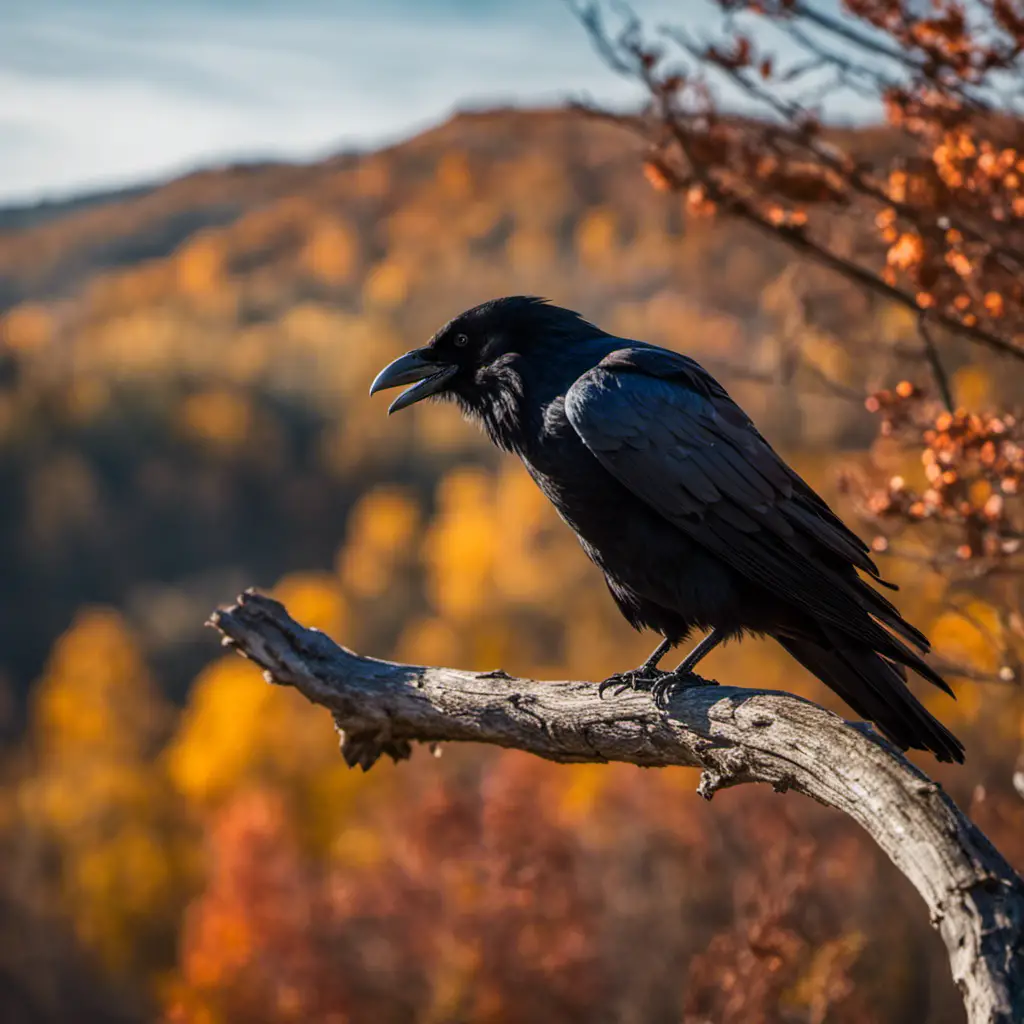
Have you ever heard the distinctive croaking call of a Common Raven? These majestic birds are known for their deep, resonant voices that echo through the forests. Common Ravens are found in a variety of habitats, including forests, mountains, and deserts. They have a diverse diet, feeding on carrion, small mammals, birds, eggs, and even garbage. Their intelligence and adaptability allow them to thrive in a wide range of environments.
When it comes to mating and nesting behavior, Common Ravens are monogamous and form lifelong pair bonds. They build large, sturdy nests made of sticks and lined with soft materials. These nests are usually located high up in trees or on cliffs, providing a safe place for their eggs and young. The female typically lays 3-7 eggs, which both parents take turns incubating for about 18-21 days. Once hatched, the young ravens are cared for by both parents for several months until they are ready to leave the nest.
| Common Raven | |
|---|---|
| Habitat | Forests, mountains, deserts |
| Diet | Carrion, small mammals, birds, eggs, garbage |
| Mating and Nesting Behavior | Monogamous, lifelong pair bonds, large stick nests, high up in trees or on cliffs, 3-7 eggs, both parents incubate, parental care for several months |
Canada Goose

You should definitely try to spot a flock of Canada Geese flying overhead during their annual migration. These majestic birds are known for their distinctive honking calls and V-formation flight patterns.
Here are some interesting facts about Canada Geese and their migration:
Canada Geese are one of the largest waterfowl species, with adults typically weighing between 7 and 14 pounds.
Their migration patterns are impressive, as they can travel thousands of miles each year, from their breeding grounds in Canada and the northern United States to their wintering grounds in the southern United States and Mexico.
During migration, Canada Geese rely on a combination of celestial cues, landmarks, and their own internal compass to navigate.
Climate change has had a significant impact on the Canada Goose population. Warmer winters have caused some individuals to forgo migration altogether and stay in their breeding grounds, which has led to increased competition for resources.
Spotting these beautiful birds during their migration isn’t only a sight to behold but also a reminder of the impact that climate change can have on wildlife populations.
Mallard

If you’re lucky, you might spot a Mallard and a Canada Goose swimming together in the pond.
The Mallard, or Anas platyrhynchos, is a common and widely recognized duck species found throughout North America. Known for their vibrant green heads and yellow bills, Mallards are migratory birds that travel long distances during the spring and fall seasons. They breed in the northern regions and move to more temperate areas during the winter.
Bird migration is a fascinating phenomenon that allows Mallards to find suitable habitats for feeding and breeding. However, habitat conservation is crucial for the survival of Mallards and many other bird species. By preserving wetlands and protecting their natural habitats, we can ensure the continued presence of Mallards and contribute to the overall biodiversity of our ecosystems.
Wood Duck
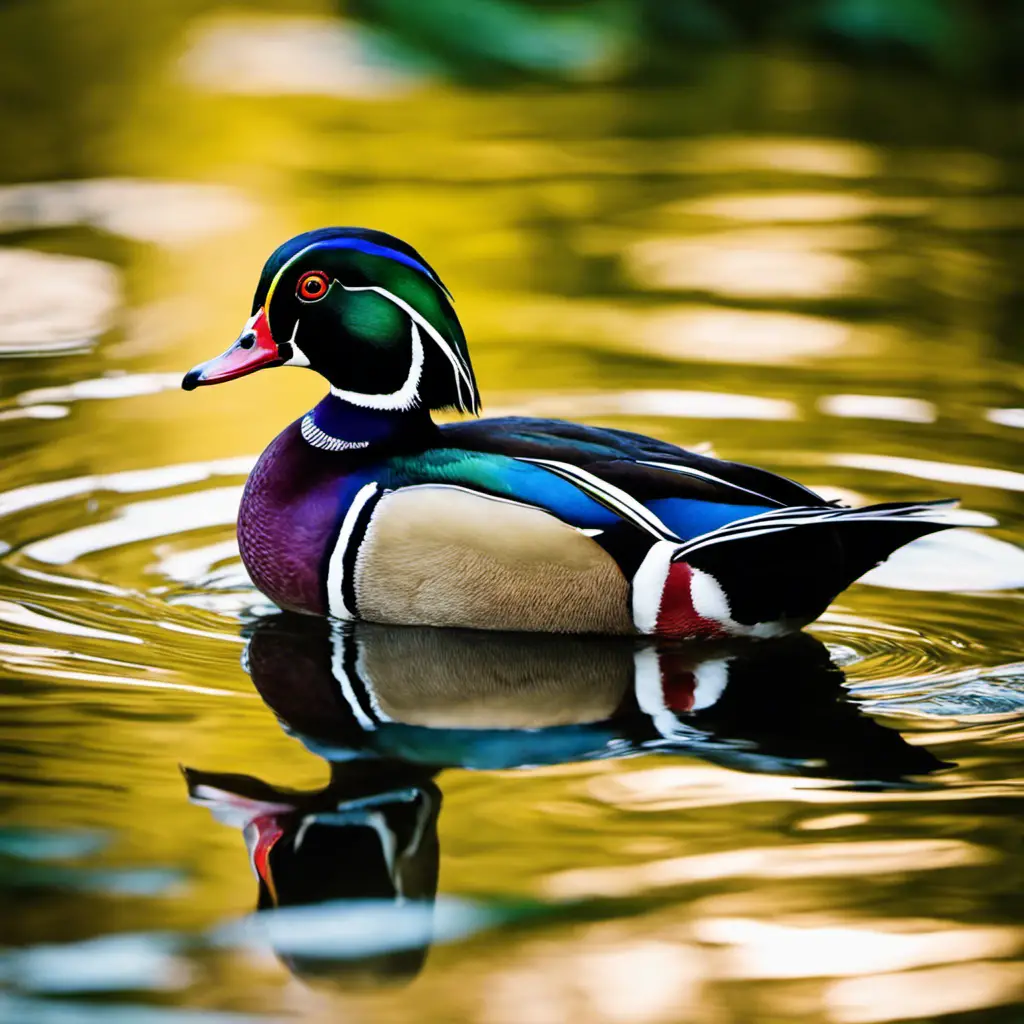
You can often see a beautiful Wood Duck swimming gracefully in the pond, or flying overhead with its distinctive plumage and elegant movements. This stunning bird is known for its unique breeding habits and the conservation efforts being made to protect its population.
- Wood duck breeding habits:
- They nest in tree cavities near water bodies.
- The female lays around 9-14 eggs.
- The male leaves the female after egg-laying and doesn’t participate in incubation.
- The ducklings jump from the nest, guided by the female, within a day of hatching.
Wood duck conservation efforts:
- Habitat protection and restoration:
- Preserving wetlands and wooded areas for nesting.
- Creating artificial nest boxes to compensate for declining natural cavities.
- Hunting regulations:
- Implementing bag limits and hunting seasons to ensure sustainable harvest.
- Promoting responsible hunting practices to avoid overharvesting.
Understanding the Wood Duck’s breeding habits and supporting conservation efforts are crucial for ensuring the survival of this magnificent species.
American Goldfinch

Spotting an American Goldfinch in your backyard can bring you a sense of tranquility as you marvel at its vibrant yellow plumage. This small songbird, known scientifically as Spinus tristis, is a common sight in North America, particularly during the summer months.
The American Goldfinch is known for its distinctive flight pattern, with a series of undulating dips and rises. These birds are highly migratory, with populations traveling from Canada and the northern United States to the southern parts of the continent during the winter months.
When it comes to feeding habits, American Goldfinches primarily consume seeds, particularly from plants such as sunflowers and thistles. Their unique beak structure allows them to extract the seeds with precision.
House Sparrow
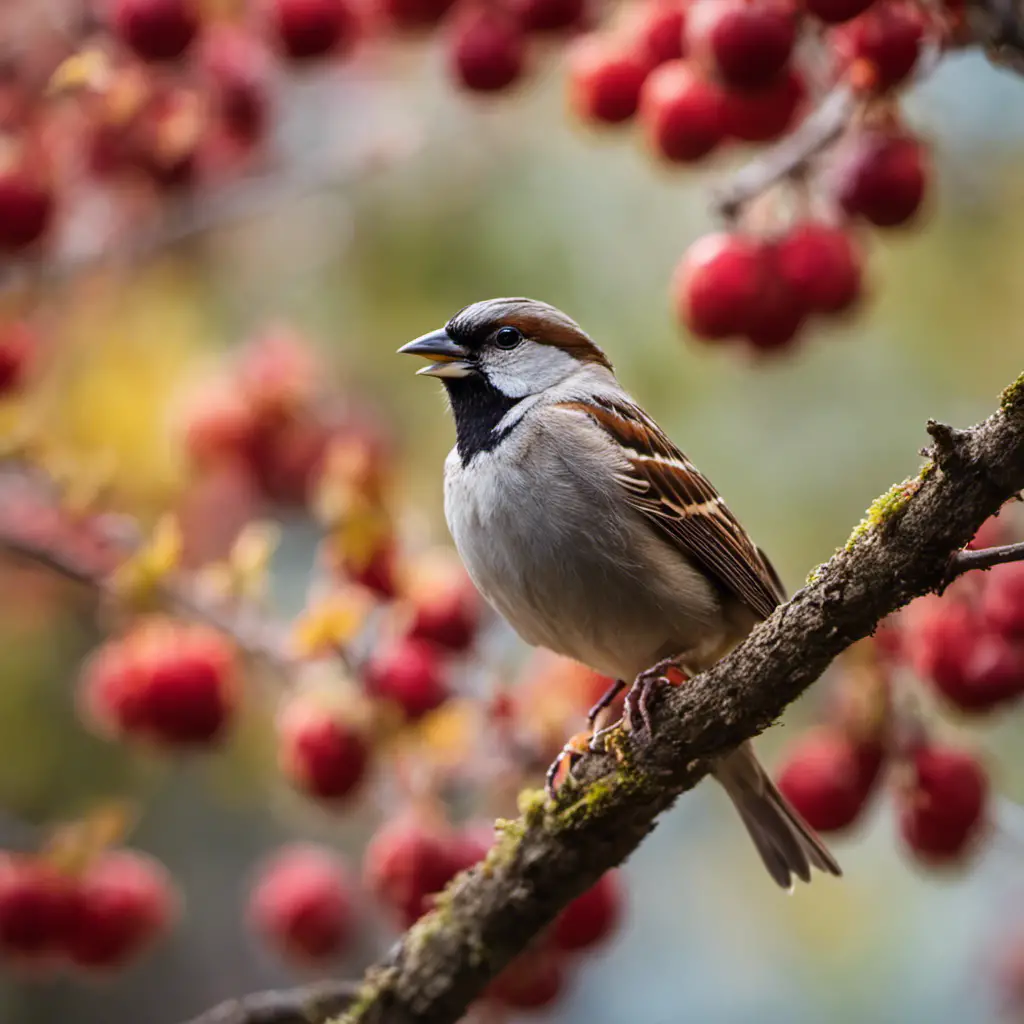
Have you noticed how the House Sparrow’s population has significantly declined in recent years? This once abundant bird species has experienced a worrisome decrease in numbers, which has raised concerns among scientists and bird enthusiasts alike.
The decline in the House Sparrow population has prompted extensive research to understand the underlying factors contributing to this decline. Here are some key points to consider regarding House Sparrow behavior:
- House Sparrows are highly adaptable birds that have successfully colonized urban environments.
- They’re social birds, often seen in large flocks, and have a hierarchical social structure.
- House Sparrows are opportunistic feeders, consuming a variety of food sources including grains, seeds, and insects.
- They exhibit complex breeding behaviors, constructing nests in cavities and displaying courtship rituals.
Understanding the behavior and ecology of House Sparrows is crucial for developing effective conservation strategies to mitigate their population decline. Further research is needed to identify the specific factors causing this decline and to implement targeted conservation efforts.
Song Sparrow
The Song Sparrow is a common sight in Pennsylvania, and its melodic songs can be heard throughout the state. This bird species, scientifically known as Melospiza melodia, is characterized by its brown streaked plumage and a distinct dark spot on its chest. Song Sparrows are known for their complex vocalizations, which they use to communicate with other members of their species. They are highly adaptable and can be found in a variety of habitats, including grasslands, marshes, and gardens. Song Sparrows are also known to migrate, with some individuals traveling long distances to reach their breeding grounds. During migration, they display interesting behaviors such as flying in flocks and making stopovers to rest and refuel. Overall, the Song Sparrow is a fascinating bird species that adds beauty and charm to the Pennsylvania landscape.
| Feature | Description |
|---|---|
| Scientific name | Melospiza melodia |
| Plumage color | Brown streaked |
| Chest spot | Distinct dark spot |
| Vocalizations | Complex and melodic songs |
| Habitat | Grasslands, marshes, gardens |
Dark-eyed Junco
You might spot a flock of three or four Dark-eyed Juncos hopping around your backyard. These small birds, with their dark gray heads and backs, white bellies, and pink bills, are a common sight in North America.
Here are some interesting facts about the Dark-eyed Junco:
Habitat: Dark-eyed Juncos can be found in a variety of habitats, including forests, woodlands, and suburban areas. They prefer areas with dense vegetation and ample ground cover.
Behavior: Dark-eyed Juncos are known for their unique hopping behavior, as they forage for seeds and insects on the ground. They also engage in social behaviors, forming flocks during the winter and breeding season.
Feeding: Their diet consists mainly of seeds, berries, and insects. They’re ground feeders and can often be seen scratching the leaf litter in search of food.
Breeding: Dark-eyed Juncos are monogamous and typically build their nests on or near the ground. The female incubates the eggs while the male provides food for both her and the chicks.
Observing these fascinating birds in your backyard can provide insight into their habitat preferences and behavior, adding to our understanding of these remarkable creatures.
White-throated Sparrow
If you look closely, you can spot a group of White-throated Sparrows hopping around the bushes in your backyard. These small birds are a common sight in North America, known for their distinctive white throat patch and yellow lores.
White-throated Sparrows are migratory birds, spending the summer breeding season in the northern parts of the continent and then migrating south for the winter. Their migration patterns are unique, with some individuals traveling short distances and others undertaking long journeys.
Understanding these patterns is crucial for bird conservation efforts, as it helps scientists identify important stopover sites and wintering grounds. By studying the behavior and movements of White-throated Sparrows, researchers can gain valuable insights into the health of their populations and implement effective conservation strategies to protect these beautiful birds.
Tufted Titmouse
You can easily recognize a Tufted Titmouse by its distinctive crest and black markings around its eyes. This small songbird, found in the eastern United States, is known for its unique behavior patterns and habitat preferences.
Behavior patterns:
- Tufted Titmice are highly social birds and often travel in small flocks.
- They’re acrobatic and can hang upside down while foraging for food.
- These birds are curious and will investigate their surroundings, often coming close to humans.
- Tufted Titmice communicate using various vocalizations, including whistles, calls, and songs.
Habitat preferences:
- They’re commonly found in deciduous forests and woodlands.
- Tufted Titmice prefer habitats with a mix of trees and shrubs, providing both food and shelter.
- They’re cavity nesters and will use old woodpecker holes or nest boxes.
- These birds are adaptable and can also be found in suburban areas with suitable vegetation.
Carolina Chickadee
There are two species of chickadees in Pennsylvania, the Carolina Chickadee and the Black-capped Chickadee, and they can be easily distinguished by their calls and appearance. The Carolina Chickadee, known by its scientific name Poecile carolinensis, is a small songbird that commonly inhabits deciduous forests, woodlands, and suburban areas throughout the state. It prefers areas with dense vegetation and a variety of trees, where it can find sufficient food and suitable nesting sites.
One of the most distinctive features of the Carolina Chickadee is its vocalizations. It has a clear, whistled song that consists of two or three high-pitched notes followed by a descending trill. This song is used for communication between individuals and to establish territory boundaries.
In addition to their vocalizations, Carolina Chickadees also communicate through various visual signals. They use body postures, such as raising their crests or flicking their wings, to convey information to other birds. These signals are important for maintaining social hierarchies and coordinating group activities.
Overall, the Carolina Chickadee is a fascinating species with unique habitat preferences and complex vocal and visual communication systems. Understanding these aspects of their behavior is crucial for conservation efforts and ensuring their continued presence in Pennsylvania’s ecosystems.
Blue Jay
You can easily identify the Blue Jay by its vibrant blue plumage and its distinctive call. This species of bird is known for its striking appearance and loud vocalizations. Here are some interesting facts about the Blue Jay:
The Blue Jay’s diet consists of a variety of foods, including nuts, seeds, berries, insects, and occasionally small vertebrates. They’ve been known to steal food from other birds and even scavenge from human garbage.
Blue Jays are skilled nest builders, constructing their nests in trees and shrubs using twigs, grass, and other plant materials. They often build large, bulky nests with a cup-shaped interior to protect their eggs and young.
Female Blue Jays are primarily responsible for incubating the eggs, while the male assists in providing food for the female during this time.
Blue Jays are territorial birds and will aggressively defend their nesting sites from intruders or other threats.
Understanding the Blue Jay’s diet and nesting habits provides valuable insights into their behavior and ecological role.
Frequently Asked Questions
What Is the Average Wingspan of the Northern Goshawk?
The average wingspan of the northern goshawk is around 3.3 to 4.2 feet. With their powerful wings and sharp talons, these birds are skilled hunters, using techniques such as stealth and quick aerial attacks.
How Does the Diet of the Cooper’s Hawk Differ From That of the Sharp-Shinned Hawk?
The diet of the Cooper’s hawk differs from that of the Sharp-shinned hawk in terms of hunting techniques and nesting habits. The Cooper’s hawk tends to hunt larger prey and build larger nests compared to the Sharp-shinned hawk.
Where Is the Best Place to Spot the Eastern Screech-Owl in Pennsylvania?
The best time to spot the eastern screech-owl in Pennsylvania is during the spring breeding season. This is when they are most active and vocal. Look for them in wooded areas with suitable nesting sites.
What Is the Primary Habitat of the Northern Harrier?
The primary habitat of the northern harrier is diverse, including marshes, wet meadows, and grasslands. This preferred environment provides ample hunting grounds for the bird, as it relies on small mammals and birds for sustenance.
How Does the Behavior of the Peregrine Falcon Differ From That of the Red-Tailed Hawk?
The behavior of the peregrine falcon differs from that of the red-tailed hawk in terms of hunting strategies and nesting habits. The peregrine falcon is known for its impressive hunting speed, while the red-tailed hawk is known for its soaring and perching techniques.
Are Finches Considered to be the Largest Birds in Pennsylvania?
Finch species in pennsylvania come in various sizes, but they are not considered the largest birds in the state. Some common finches, like the American Goldfinch and House Finch, are small, colorful songbirds that add beauty and melody to the Pennsylvania landscape. However, when it comes to size, larger birds like hawks or herons take the spotlight.
Conclusion
In conclusion, Pennsylvania is home to a diverse range of bird species, including some of the largest birds in the region. The majestic Bald Eagle, Northern Harrier, Sharp-shinned Hawk, Cooper’s Hawk, and Northern Goshawk can be found soaring through the skies.
Additionally, the White-throated Sparrow, Tufted Titmouse, Carolina Chickadee, and Blue Jay add color and charm to the state’s avian population. Pennsylvania offers a rich habitat for these impressive birds, making it a haven for birdwatchers and nature enthusiasts alike.

An avid ornithologist, zoologist and biologist with an unwavering passion for birds and wild animals.
Dr. Wilson’s journey in ornithology began in childhood and led him to obtain a Ph.D. in Ornithology from the prestigious Avian Research Institute. He has worked closely with renowned experts in the field and conducted extensive research and field studies globally.
